1994 PONTIAC BONNEVILLE warning lights
[x] Cancel search: warning lightsPage 6 of 290
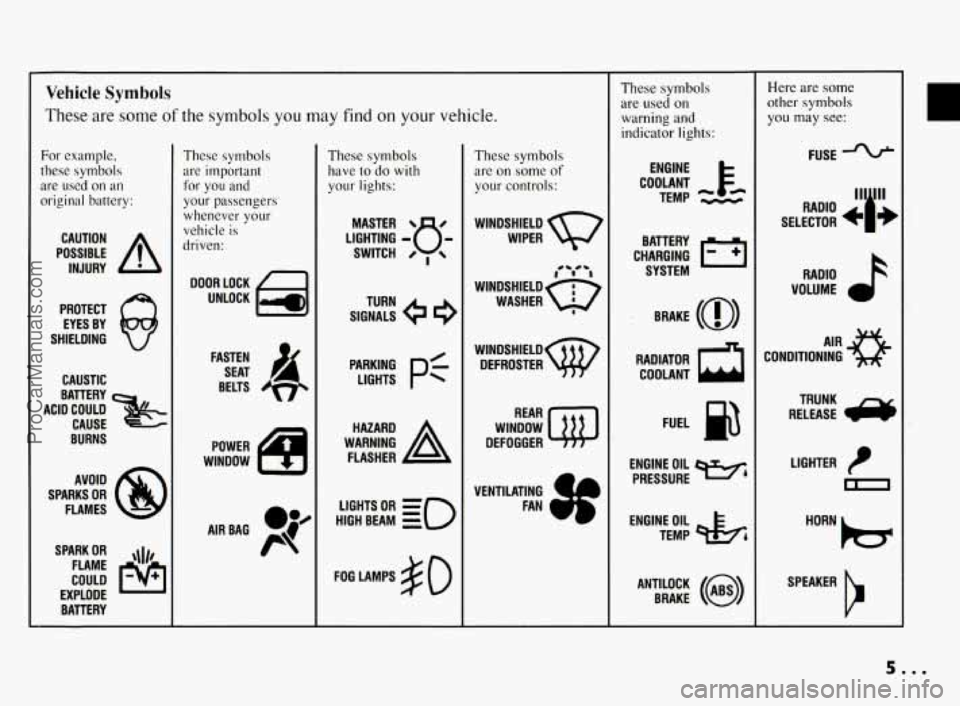
Vehicle Symbols
These are some of the symbols you may find on your vehicle.
For example,
these symbols
are used on an
original battery:
POSSIBLE A
CAUTION
INJURY
PROTECT EYES BY
SHIELDING
CAUSTIC
ACID COULD BATTERY
CAUSE
BURNS
AVOID
SPARKS
OR
FLAMES
SPARK
OR ,111,
COULD FLAME
EXPLODE BATTERY
These symbols
are important
for you and
your passengers
whenever your
vehicle
is
driven:
DOOR LOCK
UNLOCK
FASTEN SEAT
4
BELTS
POWER
WINDOW
'* -- I
These symbols
have to do with
your lights:
SIGNALS e
TURN
HIGH BEAM
OR = =o
FOG LAMPS $0
These symbols
are
on some of
your controls:
WIPER Q7
WINDSHIELD
DEFROSTER
WINDOW
DEFOGGER
VENTILATING
4
FAN (I
These symbols
are used
on
warning and
indicator lights:
COOLANT Fa
TEMP --
ENGINE
CHARGING
I-1
BATTERY SYSTEM
BRAKE
(0)
RADIATOR COOLANT
FUEL
ENGINE OIL
PRESSURE
Wb
TEMP OIL ?b
ANTILOCK (@)
BRAKE
Here are some
other symbols
you may see:
FUSE
11lp RADIO , - -
SELECTOR b I JE
RADIO
VOLUME
CONDITIONING
AIR 43
LIGHTER
m
SPEAKER
b
5.00
ProCarManuals.com
Page 54 of 290
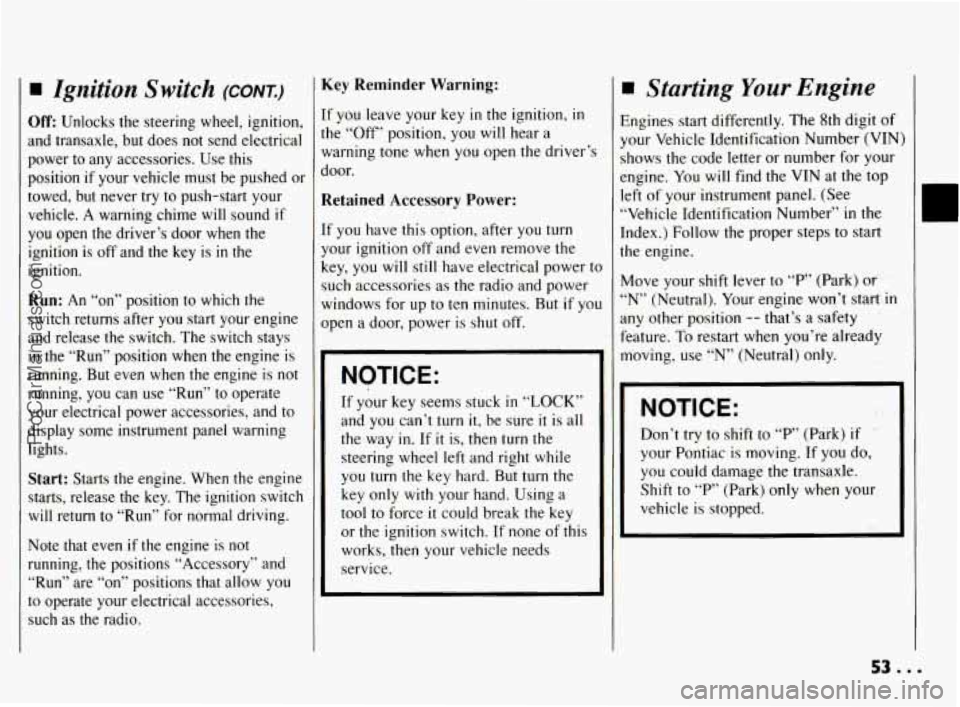
Ignition Switch (CONK)
Off: Unlocks the steering wheel, ignition,
and transaxle, but does not send electrical
power to any accessories. Use this
position
if your vehicle must be pushed or
towed,
but never try to push-start your
vehicle.
A warning chime will sound if
you open the driver’s door when the
ignition is off and the key is
in the
ignition.
Run: An “on” position to which the
switch returns after you start your engine
and release the switch. The switch stays
in the “Run” position when the engine is
running. But even when the engine is not
running, you can use “Run” to operate
your electrical power accessories, and to
display some instrument panel warning
lights.
Start: Starts the engine. When the engine
starts, release the key. The ignition switch
will return to “Run” for normal driving.
Note
that even if the engine is not
running, the positions “Accessory” and
“Run” are “on” positions that allow you
to operate your electrical accessories,
such as the radio.
Key Reminder Warning:
If you leave your key in the ignition, in
the “Off’ position, you will hear a
warning tone when you open the driver’s
door.
Retained Accessory Power:
If you have this option, after you turn
your ignition
off and even remove the
key, you
will still have electrical power to
such accessories as the radio and power
windows for
up to ten minutes. But if you
open
a door, power is shut off.
NOTICE:
If your key seems stuck in “LOCK”
and you can’t turn it, be sure it is all
the way
in. If it is, then turn the
steering wheel left and right
while
you turn the key hard. But turn the
key only
with your hand. Using a
tool to force it could break the key
or the ignition switch. If none
of this
works,
then your vehicle needs
service.
Starting Your Engine
Engines start differently. The 8th digit of
your Vehicle Identification Number (VIN)
shows the code letter or number for your
engine. You
will find the VIN at the top
left of your instrument panel. (See
“Vehicle Identification Number”
in the
Index.) Follow the proper steps to start
the engine.
Move your shift lever to
“P’ (Park) or
“N” (Neutral). Your engine won’t start in
any other position -- that’s a safety
feature. To restart when you’re already
loving, use
“N” (Neutral) only.
NOTICE:
Don’t try to shift to “P” (Park) if
your Pontiac is moving. If you do,
you could damage the transaxle.
Shift to
“P” (Park) only when your
vehicle is stopped.
ProCarManuals.com
Page 76 of 290
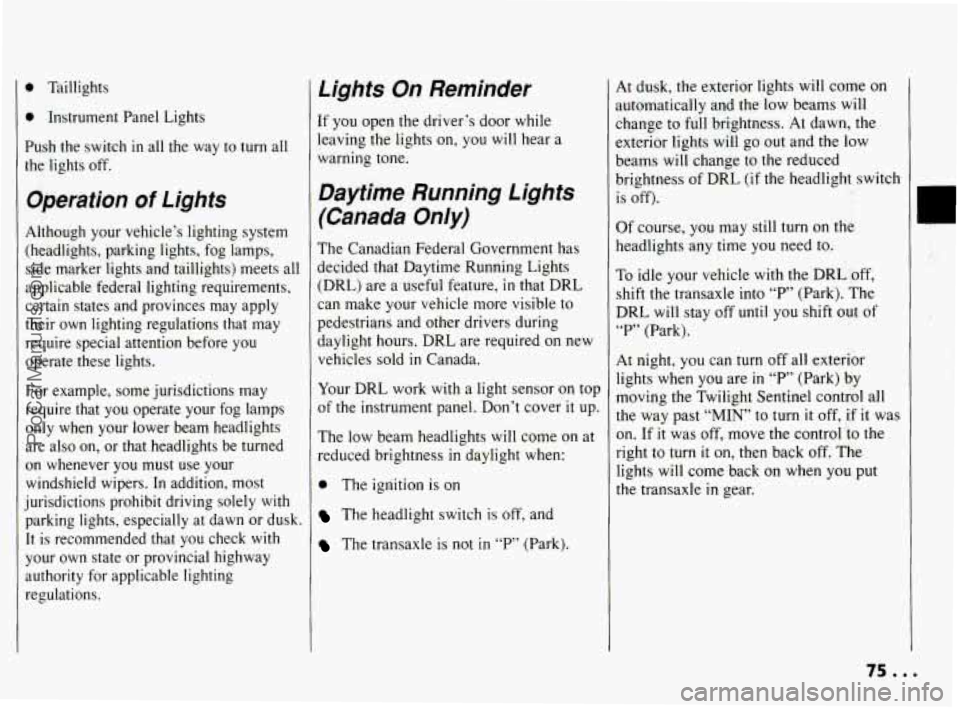
0 Taillights
0 Instrument Panel Lights
Push the switch
in all the way to turn all
the lights off.
Operation of Lights
Although your vehicle’s lighting system
(headlights, parking lights, fog lamps,
side marker lights and taillights) meets all
applicable federal lighting requirements,
certain states and provinces may apply
their own lighting regulations that may
require special attention before you
operate these lights.
For example, some jurisdictions may
require that you operate your fog lamps
only when your lower beam headlights
are also on, or that headlights be turned
on whenever you must use your
windshield wipers. In addition, most
jurisdictions prohibit driving solely
with
parking lights, especially at dawn or dusk.
It is recommended that you check with
your own state or provincial highway
authority for applicable lighting
regulations.
Lights On Reminder
[f you open the driver’s door while
leaving the lights on, you will hear a
warning tone.
Daytime Running Lights
(Canada Only)
The Canadian Federal Government has
decided that Daytime Running Lights
(DRL) are a useful feature,
in that DRL
can make your vehicle more visible to
pedestrians and other drivers during
daylight hours. DRL are required on new
vehicles sold
in Canada.
Your DRL work with a light sensor on top
of the instrument panel. Don’t cover it up.
The low beam headlights will come on at
reduced brightness
in daylight when:
0 The igdition is on
The headlight switch is off, and
The transaxle is not in “P” (Park).
4t dusk, the exterior lights will come on
mtornatically and the low beams will
:hange to full brightness. At dawn, the
:xterior lights will go out and the low
beams will change to the reduced
brightness of DRL (if the headlight switch
is off).
Of course, you may still turn on the
headlights any time you need to.
To idle your vehicle with the DRL ,off,
shift the transaxle into “P’ (Park). The
DRL will stay off until you shift out of
“P” (Park).
At night, you can turn off all exterior
lights when you are
in “P” (Park) by
moving the Twilight Sentinel control all
[he way past
“MIN” to turn it off, if it was
m. If it was off, move the control to the
right to turn it on, then back off. The
lights will come back on when you put
the transaxle
in gear.
75.0.
ProCarManuals.com
Page 89 of 290
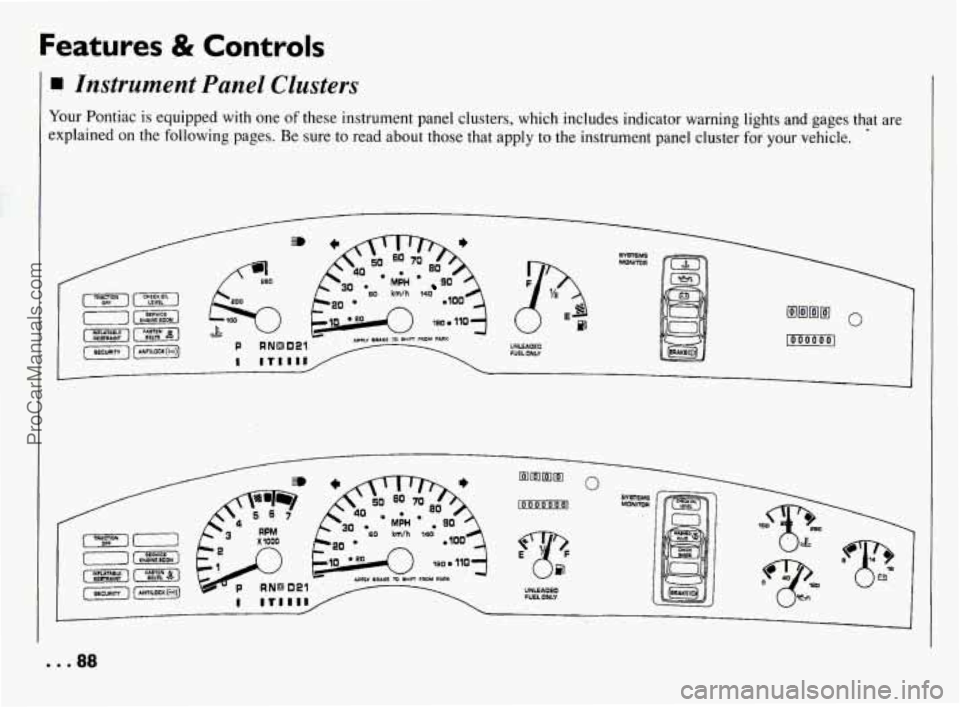
Features 8t Controls
Instrument Panel Clusters
Your Pontiac is equipped with one of these instrument panel clusters, which \
includes indicator warning lights and gages that are
explained
on the following pages. Be sure to read about those that apply to the instrument panel cluster for your vehicle.
30 *60 kmlh (40 MPH 90
eo '
I
UNLEADED NELONLV
loooooool
UNLEAOEO
FUEL ONLY
ProCarManuals.com
Page 92 of 290
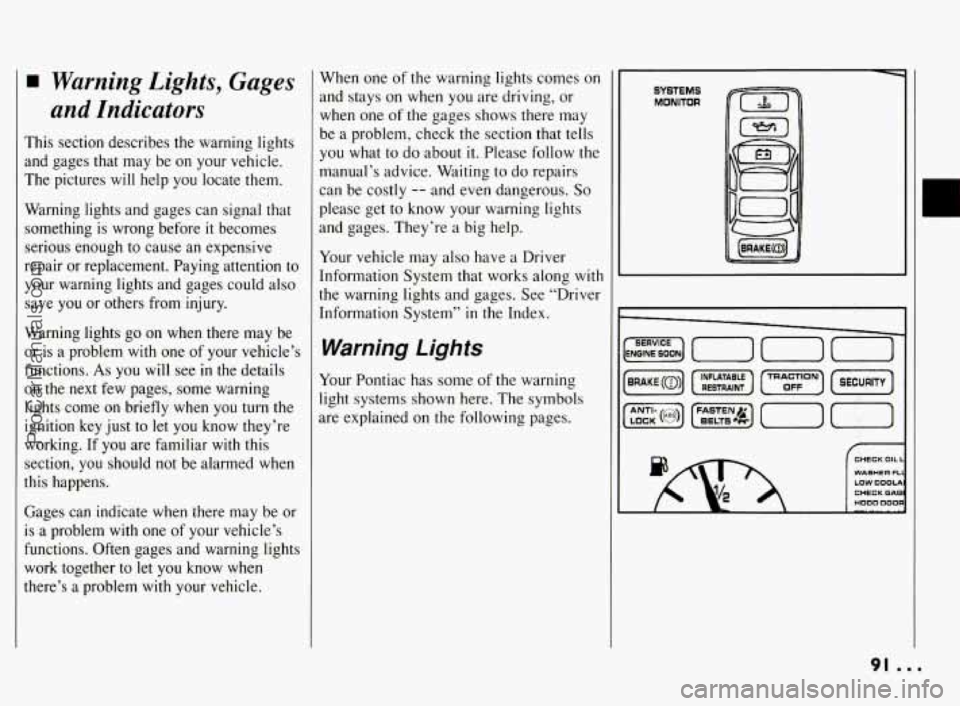
Warning Lights, Gages
and Indicators
This section describes the warning lights
and gages that may be on your vehicle.
The pictures will help you locate them.
Warning lights and gages can signal that
something is wrong before it becomes
serious enough to cause an expensive
repair or replacement. Paying attention to
your warning lights and gages could also
save you or others from injury.
Warning lights go on when there may be
or is a problem with one of your vehicle’s
functions.
As you will see in the details
on the next few pages, some warning
lights come on briefly when you turn the
ignition key just to let you know they’re
working. If you are familiar with this
section, you should not be alarmed when
this happens.
Gages can indicate when there may be or
is a problem with one of your vehicle’s
functions. Often gages and warning lights work together to let you know when
there’s a problem with your vehicle. When one of the warning lights
comes on
and stays on when
you are driving, or
when one of the gages shows there may
be a problem, check the section that tells
you what to do about it. Please follow the
manual’s advice. Waiting to do repairs
can be costly
-- and even dangerous. So
please get to know your warning lights
and gages. They’re a big help.
Your vehicle may also have a Driver
Information System that works along with
the warning lights and gages. See “Driver
Information System”
in the Index.
Warning Lights
Your Pontiac has some of the warning
light systems shown here. The symbols
are explained on the following pages.
SYSTEMS MONITOR
[-I [T) (-1
-g r-1 [-I I-]
7 CHECK OIL
WASHER FL
CHECKOAC LOW coau
91 ...
ProCarManuals.com
Page 93 of 290
![PONTIAC BONNEVILLE 1994 Owners Manual Features & Controls
SYSTEMS MONITOR
0
(-J[=zFz]
[HeURlTY][-))
Warning Lights (CONT.)
I
I-] INFORMATION DRIVER
CHECK OIL LEVEL - LAMP
WASHER FLUID
CHECK QAQES LOW
COOLANT
moo DOOR TRUNK PONTIAC BONNEVILLE 1994 Owners Manual Features & Controls
SYSTEMS MONITOR
0
(-J[=zFz]
[HeURlTY][-))
Warning Lights (CONT.)
I
I-] INFORMATION DRIVER
CHECK OIL LEVEL - LAMP
WASHER FLUID
CHECK QAQES LOW
COOLANT
moo DOOR TRUNK](/manual-img/50/58378/w960_58378-92.png)
Features & Controls
SYSTEMS MONITOR
0
(-J[=zFz]
[HeURlTY][-))
Warning Lights (CONT.)
I
I-] INFORMATION DRIVER
CHECK OIL LEVEL - LAMP
WASHER FLUID
CHECK QAQES LOW
COOLANT
moo DOOR TRUNK AJAR TURN SIONAL
BACK UP TAIL
BRAKE LAMP
MILES TRIP
(][TEiir] ENGINE SOON
[E][--
Engine Coolant Temperature Warning
Light
This light tells you that your engine
coolant has overheated or your radiator
cooling fans are not working.
If you have
been operating your vehicle under normal
driving conditions, you
should pull off the
road, stop your vehicle and
turn the
engine off as soon as possible.
I #..92
ProCarManuals.com
Page 105 of 290
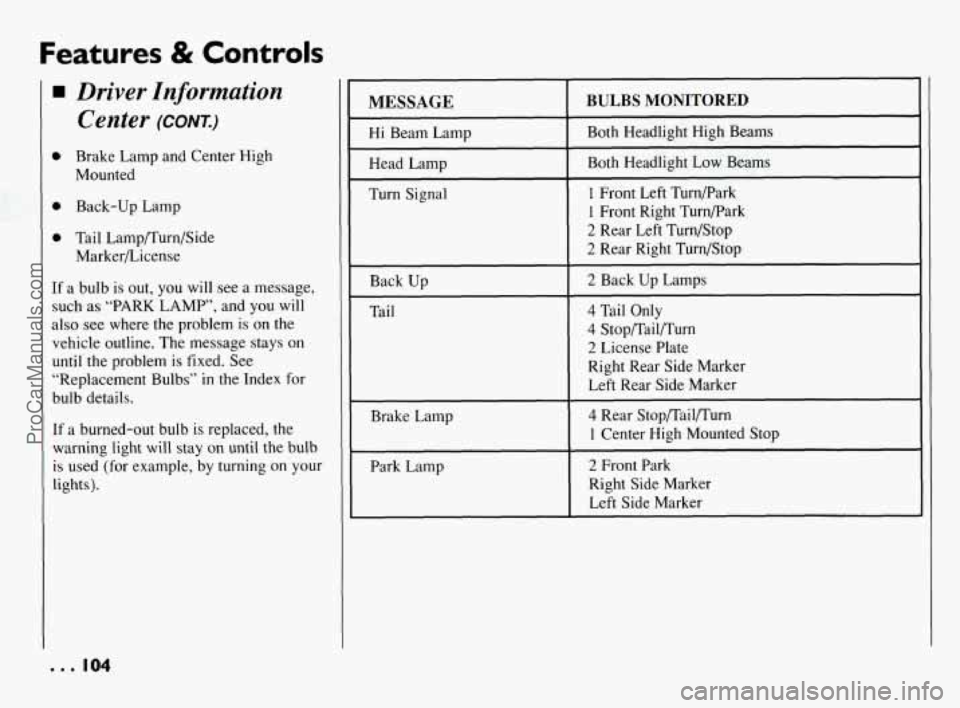
Features & Controls
Driver Information Center
(CONI)
0 Brake Lamp and Center High
Mounted
0 Back-up Lamp
0 Tail Lamp/Turn/Side
MarkerLicense
If a bulb is out, you will see a message,
such as “PARK LAMP’, and you will
also see where the problem
is on the
vehicle outline. The message stays on
until the problem is fixed. See
“Replacement Bulbs” in the Index
for
bulb details.
If a burned-out bulb is replaced, the
warning light will stay
on until the bulb
is used
(for example, by turning on your
lights).
Turn Signal
MESSAGE
Both Headlight Low Beams
Head Lamp Both Headlight
High Beams
Hi Beam Lamp
BULBS MONITORED
1 Front Left Turnpark
1 Front Right Turnpark
2 Rear Left Turn/Stop
2 Rear Right Turn/Stop
Back
Up
4 Tail Only
Tail
2 Back Up Lamps
4 Stop/Tail/Turn
2 License Plate
Right Rear Side Marker
Left Rear Side Marker
Brake Lamp
4 Rear Stop/Tail/Turn
1 Center High Mounted Stop
Park Lamp
2 Front Park
Right Side Marker
Left Side Marker
. . . 104
ProCarManuals.com
Page 108 of 290
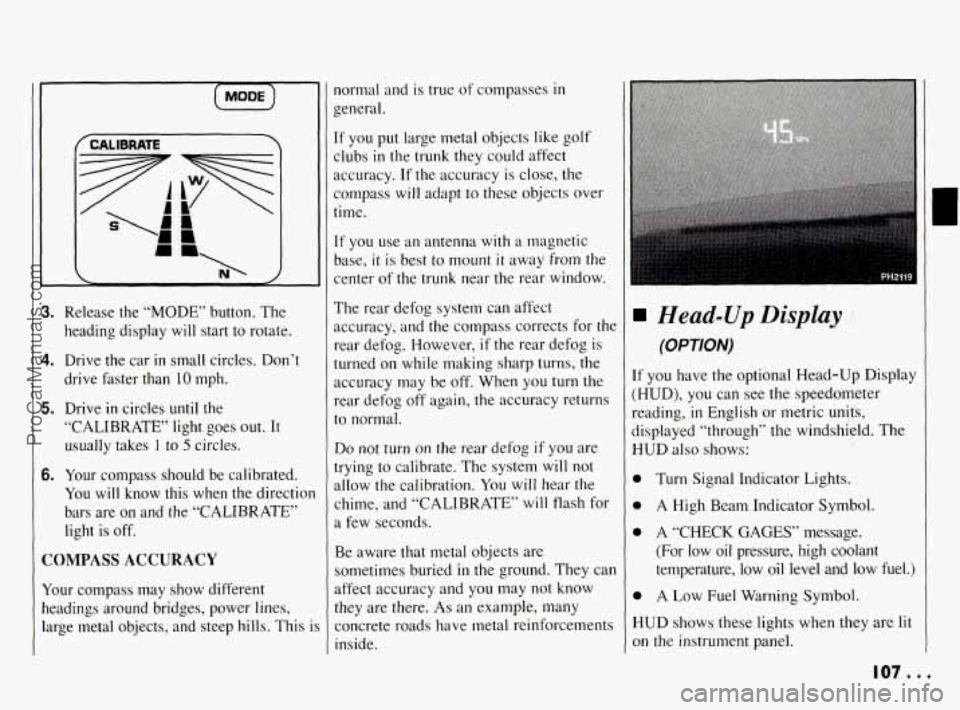
[MODE)
3. Release the “MODE” button. The
heading display
will start to rotate.
4. Drive the car in small circles. Don’t
drive faster than 10 mph.
5. Drive in circles until the
“CALIBRATE’ light goes out. It
usually takes
I to 5 circles.
6. Your compass should be calibrated.
You will know this when the directior
bars are on and the “CALIBRATE”
light is off.
COMPASS ACCURACY
Your compass may show different
headings around bridges, power lines,
large metal objects, and steep hills. This
i
normal and is true of compasses in
general.
If you put large metal objects like golf
clubs
in the trunk they could affect
accuracy.
If the accuracy is close, the
compass will adapt to these objects over
time.
If you use an antenna with a magnetic
base,
it is best to mount it away from the
center of the trunk near the rear window.
The rear defog system can affect
accuracy, and the compass corrects for the
rear defog. However,
if the rear defog is
turned on while making sharp turns, the
accuracy may be
off. When you turn the
rear defog
off again, the accuracy returns
to normal.
Do not turn on the rear defog if you are
trying
to calibrate. The system will not
allow the calibration.
You will hear the
chime, and “CALIBRATE’ will flash for
a few seconds.
Be aware that metal objects are
sometimes buried
in the ground. They can
affect accuracy and you may not know
they are there.
As an example, many
concrete roads have metal reinforcements
inside.
Head-Up Display
(OPTION)
If you have the optional Head-Up Display
(HUD),
you can see the speedometer
reading,
in English or metric units,
displayed “through” the windshield. The
HUD also shows:
0
0
0
0
H
01
Turn Signal Indicator Lights.
A High Beam Indicator Symbol.
A
“CHECK GAGES” message.
(For low oil pressure, high coolant
temperature, low
oil level and low fuel.)
A Low Fuel Warning Symbol.
UD shows these lights when they are lit
I the instrument panel.
107 ...
ProCarManuals.com